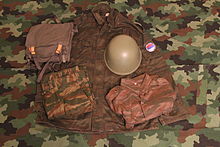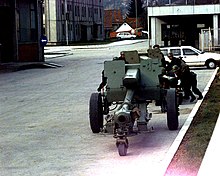Army of Republika Srpska
| Army of Republika Srpska | |
|---|---|
 | |
| Military leader | Ratko Mladić (until 1995) |
| Political leader | Radovan Karadžić (until 1995) |
| Dates of operation | 1992–2006 |
| Split from | |
| Merged into | |
| Allegiance | |
| Motives | Independence of Republika Srpska (until 1995) |
| Headquarters | Pale, Bijeljina, Banja Luka |
| Size | 80,000 at peak, 4,000 in 2005[1] |
| Allies | |
| Opponents | |
| Colours | Red, Blue, White (Serb ethnic colors) |
| Patch |  |
| Helmet decal |  |
The Army of Republika Srpska (Serbian: Војска Републике Српске/Vojska Republike Srpske; ВРС/VRS), commonly referred to in English as the Bosnian Serb Army,[2] was the military of Republika Srpska (RS), the self-proclaimed Serb secessionist republic, a territory within the newly independent Bosnia and Herzegovina (formerly part of Yugoslavia), which it defied. Active during the Bosnian War (1992–95), it continued to exist as the armed forces of RS, one of two entities making up Bosnia and Herzegovina, until 2006 when it was integrated into the Armed Forces of Bosnia and Herzegovina. Forces of the VRS engaged in a number of campaigns including Operation Corridor 92, Operation Vrbas '92, Operation Bura, Operation Spider and the army also perpetrated the siege of Sarajevo from 1992 to 1995 and the Srebrenica massacre in 1995.
Personnel[]

The Army of the Republika Srpska (VRS) was founded on 12 May 1992 from the remnants of the Yugoslav People's Army (JNA) of the former Socialist Federal Republic of Yugoslavia from which Bosnia and Herzegovina had seceded earlier in 1992. When the Bosnian War erupted, the JNA formally discharged 80,000 Bosnian Serb troops. These troops, who were allowed to keep their heavy weapons, formed the backbone of the newly formed Army of the Republika Srpska.[3]
Aside from being made up largely of ethnic Serbs from Bosnia and Herzegovina, the VRS also included ca. 4,000 foreign Orthodox Christian volunteers. 700 of whom came from Russia, and 300-800 from Bulgaria.[4][5] 100 Greeks also volunteered to fight on the side of the Bosnian Serbs, forming the Greek Volunteer Guard which allegedly participated in the Srebrenica massacre.[6]
Post-war status and abolishment[]
After the war, the country of Bosnia and Herzegovina had two armies, that of the VRS and the Army of the Federation of Bosnia and Herzegovina (AFBiH). AFBiH was itself composed out of two elements, the ARBiH and HVO. The two armies functioned without a common command, on the principle of "non-intervention in the affairs of the other". Bisera Turković noted that it was 'therefore questionable whether in say a foreign attack on Sarajevo [...the VRS] would defend this capital city'. The existence of the two separate armies was one of the factors impeding civil-military relations development.[7] The VRS conducted demining.[8]
In 2003 the army began to integrate into the Armed Forces of Bosnia and Herzegovina. In 2005 a fully integrated unit of Serbs, Bosniaks, and Croats was deployed to augment the US-led coalition forces in Iraq.[1] On 6 June 2006, it was fully integrated into the Armed Forces of Bosnia and Herzegovina controlled by the Ministry of Defence of Bosnia and Herzegovina.[9][10]
Leadership[]
The supreme commander of the VRS was General Ratko Mladić,[11] later indicted at the International Criminal Tribunal for the Former Yugoslavia (ICTY) for genocide, as were other high-ranking Serb officers. Mladić was arrested in Serbia on 26 May 2011.
Military operations[]
- Operation Corridor 92 (24 June – 6 October 1992) against Croatian forces; victory
- Operation Vrbas '92 (June – October 1992) against ARBiH and HVO; victory
- Mitrovdan offensive (8–13 November 1992) against HVO, HOS, HV; victory
- Operation Spider (December 1994) against ARBiH; victory
- Battle of Orašje (5 May – 10 June 1995) against Croatian forces; defeat
Special units[]
- Panthers Guard Special Brigade (Garda Panteri) (Специјална бригада Гарда Пантери), East-Bosnian Corps
- Wolves from the Drina, or Drina Wolves (Вукови са Дрине), Drina Corps
- Special Unit "Mando" (Специјална Јединица "Мандо"), East-Bosnian Corps
- Special Unit "Osmaci" (Специјална Јединица "Осмаци"), Drina Corps
- Serb Guard Ilidža (Српска Гарда Илиџа), Sarajevo-Romanija Corps
- White Wolves (Бели Вукови)
Organization[]


The International Criminal Tribunal for the former Yugoslavia stated that:
"In July 1995, the Armed Forces of the Republika Srpska were under the command and control of the Commander-in-Chief, Radovan Karadzic. His headquarters was in Pale.[12]
Within the framework of the VRS, immediately subordinate to the Commander-in-Chief, was the Main Staff of the VRS, headquartered in Han Pijesak and commanded by General Ratko Mladic. It was the responsibility of the Commander of the Main Staff to issue regulations, orders and instructions regarding the implementation of orders by the Commander-in-Chief, and to discharge the command duties delegated to him by the Commander-in-Chief. The Main Staff of the VRS consisted of staff officers and staff support personnel, as well as some specialised military units such as: the 65th Protection Regiment, designed to provide protection and combat services for the Main Staff; and the 10th Sabotage Detachment, a unit trained for operations behind enemy lines and other special combat assignments.
The vast majority of the fighting force of the VRS itself was divided into six geographically-based Corps, all subordinate to, and under the command of, General Mladic and, in turn, the Commander-in-Chief, Radovan Karadzic. In July 1995, the six Corps were the Drina Corps, the 1st Krajina Corps, the 2nd Krajina Corps, the Sarajevo-Romanija Corps, the Hercegovina Corps and the East Bosnia Corps."
1993[]
- 1st Krajina Corps – Banja Luka
- 2nd Krajina Corps – Drvar
- 3rd Corps – Bijeljina
- East Bosnia Corps – Han Pijesak
- Herzegovina Corps – Bileća
1995[]
- 1st Krajina Corps – Banja Luka
- 2nd Krajina Corps – Drvar
- East Bosnia Corps – Bijeljina
- Sarajevo-Romanija Corps – Pale
- Drina Corps – Han Pijesak
- Herzegovina Corps – Bileća
2001[]
- 1st Corps – Banja Luka
- 3rd Corps – Bijeljina
- 5th Corps – Sokolac
- 7th Corps – Bileća
Equipment[]
Tanks and armoured vehicles[]

Towed artillery[]

Self-propelled artillery[]
MLRS[]

ATGM[]
- AT-3 "Sagger" and AT-5 "Konkurs"
Antitank guns[]
- T-12
Self-Propelled Anti-Aircraft Guns (SPAAG)[]
- ZSU-57-2
- M53/59 Praga
- BOV-3
- ZU-23-2
MANPADs and SAMs[]
- SA-7
- SA-18
- SA-6
- SA-9
Infantry weapons[]
Pistols[]
- Zastava M88
- Zastava M57
- CZ-99
Assault rifles[]
Battle rifles[]
- Zastava M77B1
Submachine guns[]
- Zastava M56
- Zastava M85
- Zastava M92
- Heckler & Koch MP5
Machineguns[]
Sniper rifles[]
Anti-tank weapons[]
- M79 Rocket Launcher
- M80 Zolja
Republika Srpska Air Force[]
Formerly known as Ratno Vazduhoplovstva i Protiv Vazdušna Odbrana Vojske Republike Srpske or RV i PVO RS. Beginning on 1 June 2004, the Republika Srpska Air Force was officially called, Prvi Puk Vazduhoplovstva i Protiv Vazdušna Odbrana Vojske Republike Srpske, also known as 1st Aviation Regiment and Air Defence Force of the Republic of Srpska's Army.
See also[]
References[]
- ^ Jump up to: a b Nedim Dervisbegovic (2 June 2005). "Bosnia's first unified army platoon deployed to Iraq". The San Diego Union-Tribune. Archived from the original on 15 October 2007. Retrieved 26 September 2007.
- ^ AP Archive (21 July 2015). "Bosnia - Bosnian Serbs Launch Counter-Attack" – via YouTube.
- ^ John Kifner (27 January 1994). "Yugoslav Army Reported Fighting In Bosnia to Help Serbian Forces". The New York Times. Retrieved 4 March 2013.
- ^ Innes 2006, p. 157
- ^ Thomas 2006, p. 13
- ^ Helena Smith (5 January 2003). "Greece faces shame of role in Serb massacre". The Guardian. Retrieved 4 March 2013.
- ^ Philipp H. Fluri; Gustav E. Gustenau; Plamen I. Pantev (27 December 2005). The Evolution of Civil-Military Relations in South East Europe: Continuing Democratic Reform and Adapting to the Needs of Fighting Terrorism. Springer Science & Business Media. pp. 83–. ISBN 978-3-7908-1656-3.
- ^ Landmine Monitor Report 2002: Toward a Mine-free World. Human Rights Watch. 2002. pp. 121–. ISBN 978-1-56432-277-7.
- ^ Gaub, Florence (2011). Military Integration after Civil Wars: Multiethnic Armies, Identity and Post Conflict Reconstruction. Canada: Routledge. ISBN 9780203841051. Retrieved 31 March 2016.
- ^ Ramet 2010, p. 324.
- ^ "The International Criminal Tribunal for the former Yugoslavia – Case No. IT-95-5/18-I". UN – ICTY. 2007. Archived from the original on 19 September 2007. Retrieved 2007-09-26.
On 12 May 1992, Ratko MLADIC was appointed Commander of the Main Staff of the VRS, a position he held until at least 22 December 1996. On 24 June 1994, Ratko MLADIC was promoted to the rank of General Colonel.
- ^ International Criminal Tribunal for the former Yugoslavia, Military Structure of the Army of the Republika Srpska
- ^ "Roki Vulovic - Panteri / Mauzer ,English Lyrics". YouTube.
Books[]
- Innes, Michael A. (2006). Bosnian Security after Dayton: New Perspectives. Routledge. ISBN 9780203969014. Retrieved 4 March 2013.
- Ramet, Sabrina P. (2010). Central and Southeast European Politics Since 1989. Cambridge University Press. ISBN 9781139487504. Retrieved 4 March 2013.
- Thomas, Nigel (2006). The Yugoslav Wars (2): Bosnia, Kosovo and Macedonia 1992–2001. Osprey Publishing. ISBN 9781841769646. Retrieved 4 March 2013.
- Army of Republika Srpska
- 1992 establishments in Bosnia and Herzegovina
- 2006 disestablishments in Bosnia and Herzegovina
- Military of Republika Srpska
- Military units and formations established in 1992
- Military units and formations disestablished in 2006
- Military units and formations of the Bosnian War
- Serbian nationalism in Bosnia and Herzegovina
- Rebel militia groups



